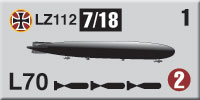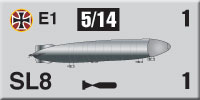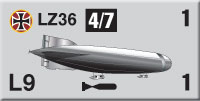Zeppelins:
Publisher’s Preview
by Mike Bennighof, Ph.D.
January 2025
 We’ve made the expansion book a centerpiece of our publishing strategy: once a game is published, that shouldn’t be the end of it as we move on to the next pre-order palooza. We want the game to be an ongoing source of fun, so we keep coming back and adding stuff. We’ve made the expansion book a centerpiece of our publishing strategy: once a game is published, that shouldn’t be the end of it as we move on to the next pre-order palooza. We want the game to be an ongoing source of fun, so we keep coming back and adding stuff.
It’s a unique approach among wargame publishers, but that’s the way role-playing games have been published for decades so it’s not an original idea. I don’t want to keep re-designing games after they’re published, but I do really like adding more cool stuff.
Great War at Sea: Zeppelins is by far our best-selling expansion book, but the games for which it provided extra scenarios have fallen out of print and rather than let it fall away as well, we revised it into a second edition.
For the second edition, I removed the scenarios and game-specific stuff. Replacing them are still more zeppelins stories: a review of all the classes of German airships that took flight during the First World War, and the story of Imperial Russia’s airships. That makes the book compatible with all Great War at Sea games, now and forever.
 Zeppelins remains my favorite book of the many I’ve written and we’ve published. Considering the iconic status of Ferdinand Graf von Zeppelin’s airships, the historiography of their military activities is surprisingly thin, particularly for airships belonging to powers other than Germany or the United States. And most of what does exist is concerned with the German zeppelin attacks against British cities rather than the airships’ naval missions. Writing Zeppelins presented the sort of challenge I like; while it’s pretty silly to think of a wargame as a “work of history,” that doesn’t mean it can’t reflect actual research and analysis. Zeppelins remains my favorite book of the many I’ve written and we’ve published. Considering the iconic status of Ferdinand Graf von Zeppelin’s airships, the historiography of their military activities is surprisingly thin, particularly for airships belonging to powers other than Germany or the United States. And most of what does exist is concerned with the German zeppelin attacks against British cities rather than the airships’ naval missions. Writing Zeppelins presented the sort of challenge I like; while it’s pretty silly to think of a wargame as a “work of history,” that doesn’t mean it can’t reflect actual research and analysis.
But the real reason I like the book is because it has giant airship pieces.
 The large pieces we use for Rome at War games to represent legions, phalanxes and barbarian war bands just happen to fit in the hexes on the Naval Tactical Map used in Great War at Sea games (there’s not a lot of space left over, but they do just barely fit). They give a nice, large canvas to decorate with lovely airship artwork. The large pieces we use for Rome at War games to represent legions, phalanxes and barbarian war bands just happen to fit in the hexes on the Naval Tactical Map used in Great War at Sea games (there’s not a lot of space left over, but they do just barely fit). They give a nice, large canvas to decorate with lovely airship artwork.
Nice as they look, the pieces add a lot more to game play beyond just the sheer fun of playing with them as they bring additional capabilities to the airships (much of which will become standard in The Wine-Dark Sea and subsequent Great War at Sea games). The earliest iterations of Great War at Sea gave airships very little to do except scout; Great War at Sea is first and foremost a battleship game and I kept that firmly in mind.
 But airships are fun and cool, and Zeppelins brings them the focus they should have had all along. They’re no longer generically the same; each class is now rated for speed and endurance. They can defend themselves from enemy aircraft (but not very well), are rated for their toughness (some are actually harder to shoot down than others) and some of them can drop bombs. The Advanced Zeppelin Leader rules give airships additional missions (Scout, Ground Attack, Naval Strike, Escort, Transport, Shadow) and they can also assist minesweepers sweeping mines. Airships can also ram each other; it’s not likely, but I love that fact that it can happen. But airships are fun and cool, and Zeppelins brings them the focus they should have had all along. They’re no longer generically the same; each class is now rated for speed and endurance. They can defend themselves from enemy aircraft (but not very well), are rated for their toughness (some are actually harder to shoot down than others) and some of them can drop bombs. The Advanced Zeppelin Leader rules give airships additional missions (Scout, Ground Attack, Naval Strike, Escort, Transport, Shadow) and they can also assist minesweepers sweeping mines. Airships can also ram each other; it’s not likely, but I love that fact that it can happen.
There’s also a wide variety of airships. Most of the new pieces included in Zeppelins are zeppelins, understandably so given Imperial Germany’s lead in airship development. There are both Navy and Army zeppelins; the Army eventually gave up on lighter-than-air flight and transferred their airships to the Navy. Of the 88 super-sized airship pieces in the Zeppelins set, 52 of them are from the Imperial German Navy and five more belong to the Army.
 But we went far beyond the Imperial German Naval Airship Service. The Royal Italian Navy has nine large semi-rigid airships, while the British have 11 in a mix of rigid and semi-rigid types. There are five Austro-Hungarian airships, three from the U.S. Navy and one each from Russia, France and the U.S. Army. But we went far beyond the Imperial German Naval Airship Service. The Royal Italian Navy has nine large semi-rigid airships, while the British have 11 in a mix of rigid and semi-rigid types. There are five Austro-Hungarian airships, three from the U.S. Navy and one each from Russia, France and the U.S. Army.
Few of these flying gasbags are as capable as those of the Germans (except for those that were originally German, either purchased by their new owners or taken as war reparations). The British airships are the next best, with the Italians well behind. The U.S. Navy’s airships are quite capable, but none of them are American-designed and -built.
 Along with the wonderful giant pieces in many colors and the crunchy rules for their use, Zeppelins is filled with the stories of these airships. Some of those weren’t easy to come by, but we have the stories of the German Army’s airship program, whose ships mostly conducted missions over land but at times impacted naval operations. Along with the wonderful giant pieces in many colors and the crunchy rules for their use, Zeppelins is filled with the stories of these airships. Some of those weren’t easy to come by, but we have the stories of the German Army’s airship program, whose ships mostly conducted missions over land but at times impacted naval operations.
Austria-Hungary began an airship program before the war, but had only small ships lacking the range to conduct useful scouting for the fleet even in the close waters of the Adriatic. They added a more capable airship when they captured a crashed Italian semi-rigid airship, and looked to buy a pair of modern airships from the Germans – a deal never completed, but we have the pieces in our book.
Britain’s airship program is mostly remembered today, quite unfairly, for a pair of spectacular disasters – the crashes of the R38 in 1921 and R101 in 1930. Yet Britain ended the war with a large and vibrant airship industry, with multiple firms producing craft that, if not as advanced as those of the Zeppelin works, still performed better than any other competitor.
 Italy also had a well-developed program, but one concentrating on semi-rigid craft (a rigid airship has a frame, usually metal but sometimes wood, supporting its shape while a non-rigid airship has its shape maintained by gas pressure. A semi-rigid is a compromise, with a metal or wood keel along the bottom of the envelope and sometimes a framework around the lower part of the gas envelope, but most of the envelope’s shape is provided by gas pressure). These had much less range and lifting power than the big German-built or -inspired airships, but were adequate for scouting over the Adriatic Sea (where the Austrians shot down several). The U.S. Army’s big airship Roma was purchased from Italian builders, and an Italian firm also built the airship SR.1 for the British. Italy also had a well-developed program, but one concentrating on semi-rigid craft (a rigid airship has a frame, usually metal but sometimes wood, supporting its shape while a non-rigid airship has its shape maintained by gas pressure. A semi-rigid is a compromise, with a metal or wood keel along the bottom of the envelope and sometimes a framework around the lower part of the gas envelope, but most of the envelope’s shape is provided by gas pressure). These had much less range and lifting power than the big German-built or -inspired airships, but were adequate for scouting over the Adriatic Sea (where the Austrians shot down several). The U.S. Army’s big airship Roma was purchased from Italian builders, and an Italian firm also built the airship SR.1 for the British.
We’re not done with the giant airship pieces; there’s still that bombing campaign over England.
You can order Zeppelins right here.
Sign up for our newsletter right here. Your info will never be sold or transferred; we'll just use it to update you on new games and new offers.
Mike Bennighof is president of Avalanche Press and holds a doctorate in history from Emory University. A Fulbright Scholar and NASA Journalist in Space finalist, he has published a great many books, games and articles on historical subjects; people are saying that some of them are actually good.
He lives in Birmingham, Alabama with his wife, three children, and his new puppy. His Iron Dog, Leopold, could swim very well.
Want to keep Daily Content free of third-party ads? You can send us some love (and cash) through this link right here.
|
